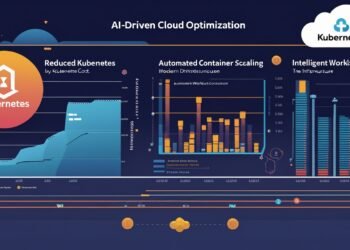The fusion of Artificial Intelligence (AI) and Industrial Internet of Things (IIoT) is driving a major transformation across industries, and leading technology firms Qualcomm and Palantir are at the forefront of this revolution. By combining Qualcomm’s cutting-edge edge AI processing with Palantir’s advanced data analytics and AI-driven software, the two companies are making AI at the edge more accessible, efficient, and scalable for industrial applications.
This partnership is a significant step forward in optimizing manufacturing, logistics, energy, and other industries that rely heavily on real-time data processing and predictive analytics. Let’s dive into the details of how Qualcomm and Palantir are reshaping the industrial IoT landscape with AI at the edge.
Qualcomm’s Strength in Edge AI and IoT
Qualcomm has long been a dominant player in the semiconductor and wireless technology sectors, known for its innovations in 5G, AI processing, and IoT solutions. The company’s Snapdragon platforms and AI-enabled processors are designed to support intelligent computing on low-power, high-performance edge devices.
Key Contributions by Qualcomm in AI and IIoT
- AI-Optimized Chips
- Qualcomm develops AI-enabled processors that bring machine learning and deep learning capabilities directly to edge devices.
- These chips are crucial in industrial settings where AI-driven insights must be generated in real-time without depending on cloud computing.
- 5G and Connectivity Solutions
- Qualcomm’s 5G modems and Wi-Fi solutions play a key role in ensuring ultra-fast, low-latency communication between industrial IoT devices.
- This connectivity is vital for IIoT applications such as predictive maintenance, remote monitoring, and autonomous operations.
- Power-Efficient AI Processing
- Qualcomm’s low-power AI hardware ensures that industrial machines and sensors can run AI models without excessive energy consumption.
- This is particularly beneficial in sectors like energy, transportation, and smart manufacturing, where power efficiency is a priority.
Palantir’s Role in AI-Powered Industrial Analytics
Palantir is a global leader in AI-driven data analytics, known for its expertise in handling large-scale data integration, predictive analytics, and machine learning. The company’s Foundry and Gotham platforms help organizations extract insights from massive datasets.
Palantir’s AI & Industrial IoT Contributions
- Data Integration Across Industrial Networks
- Palantir’s software integrates data from thousands of IoT devices, bridging the gap between raw sensor data and actionable AI insights.
- This enables industries to make informed decisions based on real-time data analysis.
- AI-Driven Predictive Maintenance & Optimization
- By leveraging AI and machine learning, Palantir provides predictive maintenance models that help industries prevent equipment failures before they happen.
- This reduces downtime, maintenance costs, and operational risks.
- Edge AI and Real-Time Decision-Making
- Palantir’s AI-driven software works seamlessly with Qualcomm’s edge computing solutions to process data locally on industrial IoT devices.
- This means businesses can react instantly to changing conditions without relying on cloud processing.
The Impact of Qualcomm & Palantir’s Collaboration
The collaboration between Qualcomm and Palantir represents a powerful convergence of AI, edge computing, and industrial IoT. Together, they are solving some of the biggest challenges in industrial AI adoption, including:
1. Real-Time AI Processing at the Edge
By integrating Palantir’s AI analytics with Qualcomm’s edge computing solutions, industries can process vast amounts of data locally—leading to faster, more efficient decision-making. This is a game-changer for applications such as automated quality control in manufacturing or real-time monitoring in smart cities.
2. Reduced Dependence on Cloud Infrastructure
One of the major bottlenecks in industrial IoT adoption has been the reliance on cloud computing for AI inference.
- Edge AI processing minimizes latency, bandwidth costs, and security concerns associated with sending industrial data to the cloud.
- This is particularly crucial in mission-critical applications, where even milliseconds of delay can lead to catastrophic failures.
3. Enhanced Cybersecurity for Industrial Systems
With industrial IoT becoming a prime target for cyber threats, Qualcomm’s secure AI chips combined with Palantir’s cybersecurity expertise ensure robust data protection at the edge.
- This is particularly beneficial for industries like defense, energy, and finance, where securing data streams is a top priority.
4. Scalable AI for Industrial Automation
The Qualcomm-Palantir collaboration paves the way for AI-powered automation in factories, logistics, and energy grids.
- AI-driven autonomous robotics, self-optimizing industrial systems, and AI-powered logistics are now more achievable at scale.
Future of AI-Driven Industrial IoT
The growing demand for autonomous industrial systems and real-time data intelligence will continue to drive advancements in edge AI and IoT. Qualcomm and Palantir’s collaboration is expected to expand into:
- Smart cities: AI-powered traffic management, energy optimization, and public safety systems.
- Supply chain optimization: Real-time tracking and predictive logistics to prevent disruptions.
- AI-enhanced healthcare: AI-driven medical diagnostics and edge computing solutions for remote healthcare applications.
Final Thoughts
Qualcomm and Palantir’s strategic partnership is unlocking new possibilities for AI-powered industrial IoT. By combining Qualcomm’s AI-driven hardware with Palantir’s intelligent analytics, industries can now deploy smarter, more efficient, and highly secure AI solutions at the edge.
This collaboration is just the beginning of a larger AI revolution in industrial settings. As edge AI continues to evolve, we can expect even more autonomous decision-making, predictive intelligence, and energy-efficient AI solutions that will shape the future of Industry 4.0.
With Qualcomm and Palantir leading the charge, the next wave of industrial IoT innovation is set to be faster, smarter, and more efficient than ever before.

















